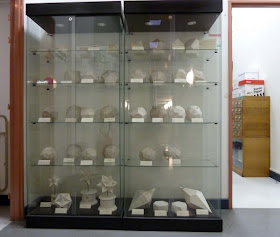When I last visited my former office in Riga couple years ago, models were gone and nobody knew where.
I remembered those models in Latvia when I saw some mathematical models on a shelf in Cornell Mathematics Library. When in 2002 I joined a team in Cornell to develop kinematic model digital library, I discovered that some of the models in the kinematic model collection were purely mathematical and I became interested in the history of models, even wrote couple papers, (the latest).
Universities late 19th century and early 20th century used to have these model collections displayed as in an art museum - you can see it in the picture of Cornell Kinematic model collection at its beginnings as published in Scientific American in 1885. Some places still have these nice model collections and have displayed them, I wish one day to go and see mathematical models in West Point ( Prof Fred Rickey has researched the history of Olivier models) recently I saw nice models in Vassar College. Some of the model collections are digitized, like The Altgeld Mathematical models collection in Illinois.
[It can be tricky to search for mathematical models on the Internet because nowadays mathematical model does not mean only the tactile model you can physically hold in your hands. Google search may return results like "mathematical model of compile time garbage collection". ]
Angela Vierling-Claassen has gathered a list of Collections of mathematical models and also has some notes on Influence of mathematical models on art.
When in Paris, we never made to Conservatoire des Arts et Métiers (on a list for next time!) but we did visited mathematical models collection in the Institut Henri Poincare. Our guides there were Brigitte Yvon-Deyme and Dominique Dartron - thank you both so much for your kindness and your time! (photos of models in this posting are used by permission of Bibliotheque IHP).
In my introduction to Crocheting Adventures with the Hyperbolic Planes I mentioned the International Congress of Mathematicians in 1954. I was trying to find some picture from this Congress but did not have any success before a book was sent to a print. Now I have a picture I would've loved to have in the book - it was the very first thing David spotted on a wall in IHP.
During the library hours anybody can visit the library to see several cases of the models on a permanent display.
With a little wink in her eyes M-me Yvon-Deyme pointed out that most of the visitors come to see models not out of mathematical curiousity but they are people interested in art, particularly the ones who wish to see models photographed by Man Ray. In the 1930s, the surrealists were interested in various geometries. According to Neil Baldwin, Max Ernst "had taken Man Ray to see the objects on display at the Poincare institute in Paris and had photographed them in a deliberately impressionistic style". These are some of Man Ray's pictures.
Man Ray's photographs were published in Cahiers d'Art (May 1936, No. 1-2, p. 21-26.) and the series was first shown at the New Burlington Gallery (June 11- July 4, 1936).
Man Ray very much agreed with Henri Vuibert who wrote in 1912:
To help students see in space, we materialized the major figures of geometry and descriptive geometry. The use of figures in relief would provide valuable aid to education, especially if one was building these figures by the students." (Anaglyphs The geometric . Paris: Librairie Vuibert, 1912, p. 8).Man Ray returned to these mathematical models about a decade later when he created series of paintings Shakespearean Equations.
| Man Ray Shakespearean Equations: Twelfth Night, 1948 :Hirshhorn Museum |
| Man Ray Shakespearean Equations: King Lear, 1948: Hirshhorn Museum |
Surrealists interest sparked public interest about IHP mathematical models and since then the models of the IHP have participated in many exhibitions starting with the one at the Palais de la Découverte, built for the Exposition Internationale des Arts in 1937.
On a personal note here I should add that my interest about 1937 exhibition was because of mathematical models and surprised I discovered that famous sculpture Worker and Kolkhoz Woman by Vera Mukhina (born in Riga!) was the centerpiece of Soviet Pavillion in this exhibition. For me that sculpture always associated with the VDNH (Exhibition of Achievements of the People's Economy) in Moscow and also with the opening of Mosfilm movies.
Here are some of my photos of mathematical models in IHP in Paris.
These constant width solids caught my interest because they are generalization of the curves with constant width.
Among all of the IHP mathematical models there will now also be a place for crocheted hyperbolic plane :-) PS. Geometry continues to be the inspiration for artists - as one can see it in current exhibit Geometric Days.















Superb visual geometrics! Or is it mathematical arts? Anyway, it's absolutely amazing and visually beautiful.
ReplyDeleteHere is the answer to April fool's part in this post - there is no equation for the object in that last Man Ray's picture - it is just a stand for a model that has been lost.
ReplyDeleteOld-fashioned or not, there's something much more intuitive in a 3-D geometrical model that you can touch and rotate in your hands than in a computer-generated 3-D drawing.
ReplyDeleteAny idea what the equation is for the first picture after "these are some of Man Ray's pictures"?
ReplyDeleteWarren - I do not really have notes on all models, you can write to the Henri Poincare Institute - they should be able to tell because all models were marked what is their equation. My guess it is one of 4th degreee algebraic surfaces.
ReplyDeleteThanks for the great pictures! - David Press (ISAMA)
ReplyDeletecan somebody list some of the models used by man ray and the ideas they represent? I found this missing and it is so important to understand.
ReplyDeleteThat is true! An important missing information.
Delete